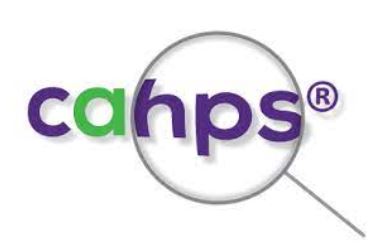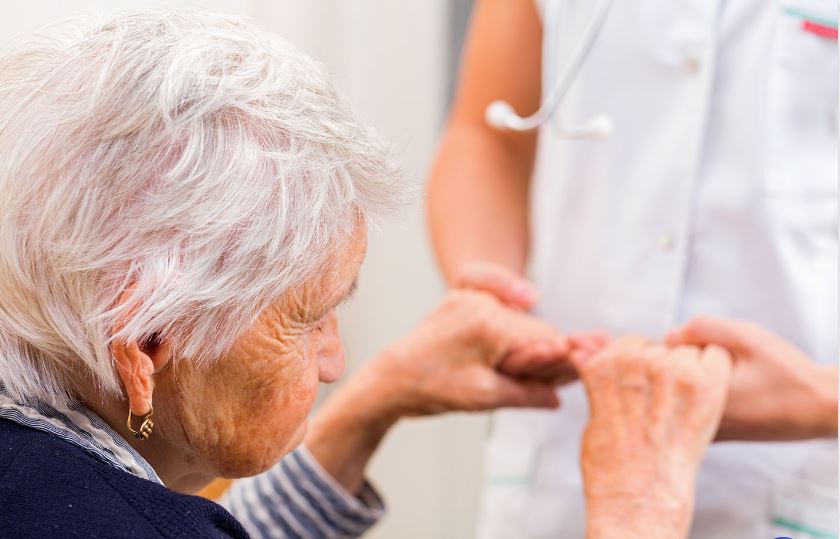
by editor | Nov 7, 2022 | Compliance and Regulatory - Directors, Documentation - Nurses, Hospice 101 - Nurses, Metrics and KPIs, Rules and Regulations - Nurses
What is the CAHPS hospice survey?
The CAHPS hospice survey is administered to eligible caregivers after a patient’s death to measure the quality of care and communication provided by the hospice. A hospice agency must participate in the CAHPS Hospice Survey to be eligible for its full annual payment update (APU). Failure to participate will result in a 2% reduction in APU. For example, compliance with the 2022 CAHPS Hospice Survey affects fiscal year 2024 APU.
Are all hospices required to administer the CAHPS hospice survey?
All Medicare certified hospice agencies should participate in the CAHPS hospice survey with two exceptions:
- Size Exemption: The exemption is based upon the number of decedents the hospice served in the prior calendar year. If the hospice served fewer than 50 survey eligible decedents or caregivers in the prior calendar year, the hospice is exempt from the CAHPS hospice survey
- Age Exemption: The exemption for age of hospice is based upon the date that the hospice received its CCN. The hospice is exempt for the remainder of the calendar year in which it receives its CCN.
CMS identifies hospices that are exempt due to age. A hospice agency is not required to file a form to request Age Exemption.
CMS does not identify hospices that are exempt for due to size. A hospice agency must apply for a Size Exemption and must apply for the Size Exemption each year that it wishes to be eligible for this exemption.
How does a hospice apply for a Size Exemption?
The hospice must complete a Participation Exemption for Size Form. The form, deadlines for submission, and details for completion can be found here.
The form requires not only a count of total patients who died while in hospice care, but certain details about these patients to determine the count of survey eligible patients and caregivers. For example, the hospice will need to submit counts of the number of patients
- who were under 18 when they died
- where there is no caregiver on record
- who died within 48 hours of final admission to hospice care
and several other categories. Care must be taken that patients are only counted in one of the categories even if they fall into multiple categories, to eliminate double counting.
What happens once a hospice submits a size exemption form?
Immediately upon submission of the form, the CAHPS Hospice Survey Project team will confirm receipt of the form. This confirmation, however, is not equivalent to Size Exemption approval. CMS will review the data to determine if the exemption is met. If CMS determines that the exemption is not met, the hospice is responsible for survey administration. Hospice agencies must accurately complete the Participation Exemption for Size Form so that they are not faced with a rejection by CMS. If the Size Exemption is not met and the hospice agency has missed administering and submitting surveys, the hospice agency will face an APU reduction.
Where can you find more information?

by editor | Nov 7, 2022 | Compliance and Regulatory - Directors, Documentation - Nurses, Hospice 101 - Nurses, Metrics and KPIs, Rules and Regulations - Nurses
Why should a hospice agency use a CAHPS Hospice Survey vendor?
A hospice agency is not permitted to administer its own CAHPS Hospice Surveys. Instead, every hospice agency is required to contract with an approved CAHPS Hospice Survey vendor. The vendor will administer the CAHPS Hospice Survey on an ongoing monthly basis and submit the data.
How can a hospice agency find an approved CAHPS Hospice Survey vendor?
CMS provides a list of approved vendors, which can be found here
Tips for selecting a survey vendor
The results of the CAHPS survey are publicly reported on Care Compare. Further, failure to submit the data timely can result in penalties from CMS. Given the significance of this survey, it is important to choose a reliable and experienced vendor that understands the hospice industry and can ensure both the quality and compliance of the data that will be submitted to CMS.
Some factors to explore when evaluating vendors include:
- Maturity of the vendor’s business and its processes. When was the business formed, number of clients, number of surveys, technologies used, operational failures, and growth in staff/changes in operations in support of growth in client base.
- Conducting the Surveys. What are survey response rates, languages supported, and mediums supported.
- Data sharing. How will patient files be shared with the vendor, does the vendor work with your EMR, is there a secure way to transmit data.
- Data Security. Has the vendor ever had a data breach, what steps are taken to ensure data protection, what steps are taken to ensure no data loss, how is data backed up, in the event of a failure how quickly will data be restored.
- Data Insights. Finally, with respect to insights, what analysis is performed on the data, what reports or dashboards does the vendor provide, does the vendor help the agency understand the results.
- Fees and Billing. Models for fees for CAHPS surveys vary by vendors. Examples may be flat price billing, fee per completed survey, fee per caregiver. Additional fees may be charged for follow ups, detailed reporting to the hospice agency, analysis shared with the agency, or access to survey data, for example.
Notifying CMS of the selected vendor
A hospice agency is required to complete a form that authorizes the CAHPS Hospice Survey vendor to collect and submit survey data to CMS. If the hospice agency does not notify CMS of this authorization, the vendor may not submit the data on behalf of the agency.
The CAHPS Hospice Survey Vendor Authorization Form is used to notify CMS of vendor authorization. The form and instructions for submission can be found here
The Vendor Authorization Form must be signed and notarized. The individual who signs the form is considered the CAHPS Hospice Survey Administrator for the hospice agency. An additional individual in the agency may be designated on the form as the primary point of contact for the survey.
Timelines
The Vendor Authorization Form must be submitted three months before data is required to be submitted.
For example, patients who die between January 2023 and March 2023 will be contacted for survey between April 2023 and June 2023. Their data will be due for submission to the CAHPS Hospice Survey Data Warehouse on August 9, 2023.
If an agency is first contracting with a vendor to begin service in January 2023, the Vendor Authorization Form would need to be submitted by May 9, 2023.
Where can you find more information?
by editor | Sep 15, 2022 | Accounts Payable, Billing, Billing - General, Compliance and Regulatory - Directors, Documentation - Nurses, Hospice 101 - Aides, Hospice 101 - Chaplain, Hospice 101 - Nurses, Hospice 101 - Office Team, Hospice 101 - Social Workers, Human Resources, Intake, Medical Records, Metrics and KPIs, Office Setup, Payroll, Rules and Regulations - Chaplains, Rules and Regulations - Nurses, Rules and Regulations - Social Workers, Rules and Regulations - Volunteers
Are you confused by the Acronym Alphabet Soup?
Does the never ending list of acronyms used in the hospice and healthcare industry leave you confused?
Are you worried that you may confuse CMN with CMP?
To help sort out the confusion, we add here links to lists of acronyms:
Use these acronym listings to help clarify things when you inevitably are faced with acronym confusion!

by editor | Sep 12, 2022 | Billing, Billing - General, Compliance and Regulatory - Directors, Documentation - Nurses, Financials, Hospice 101 - Nurses, Intake, Medical Records, Metrics and KPIs, Notice of Election, Rules and Regulations - Nurses
A hospice must file a Notice of Election (NOE) within five days after the beneficiary’s hospice admission date.
What is considered timely filing of an NOE?
For an NOE to be considered timely:
- The NOE must have a receipt date within five calendar days after the hospice admission date
- The NOE must process and finalize in status/location P B9997
For example:
- Patient admitted on 5/8
- NOE submitted on 5/13
- NOE processed on 5/27
To be timely, the NOE must have a receipt date of 5/13 and the NOE must subsequently process (P B9997)
However, if the NOE is not filed timely, Medicare will not cover and pay for the days of hospice care from the date that the patient is admitted until the date the NOE is submitted and accepted. For example:
- Admission date: 5/1
- NOE receipt date 5/10
- NOE processed 5/18
Non covered days: 5/1 through 5/9 (one day before NOE receipt date)
- Admission date 5/1
- NOE receipt date 5/10
- NOE processed 5/18
Non covered days: 5/1 through 5/9 (one day before NOE receipt date)
What happens if a hospice must resubmit an NOE due to errors?
Sometimes an NOE is submitted but it is not accepted due to a need for corrections. The NOE is “RTPd” (Returned to Provider) and is then resubmitted by the hospice. The date that the NOE is resubmitted by the hospice is considered the submission date.
How should a hospice file a claim if the NOE was filed late?
If a hospice has a late NOE, the claim must be filed showing the late filed NOE. It must also show occurrence code OSC 77, indicating the non covered dates. The claim will have two rows, one row for the non-covered days and one row for the covered days.
See Submitting Claims for Untimely NOEs for more details on billing when NOEs are untimely.
For more information on submitting claims, read some of our posts here Hospice Keys Billing Blogs

by editor | Aug 4, 2022 | Billing, Billing - General, Compliance and Regulatory, Compliance and Regulatory - Directors, Documentation - Nurses, Financials, Intake, Patient Care, Rules and Regulations - Nurses, Rules and Regulations - Office Team
Prior to the third hospice benefit period, and prior to each subsequent benefit period, a hospice physician or nurse practitioner is required to have a face to face encounter with the hospice patient to recertify that the patient continues to be Medicare eligible for hospice benefits. The face to face encounter must occur within 30 calendar days prior to the start of the third benefit period and each subsequent benefit period.
The face to face encounter is necessary to recertify that the patient remains eligible for Medicare hospice benefits. If face to face encounters are not performed timely, the patient is is no longer hospice eligible. The hospice may continue to provide hospice services to the patient but may no longer continue to bill Medicare. Instead, the hospice would need to assume all financial responsibility for the patient until such time that the hospice is able to reestablish patient hospice eligibility. The patient may be readmitted to hospice once hospice eligibility criteria are once again met.
What if there are exceptional circumstances that cause the hospice to be unable to timely complete the face to face encounter?
What are exceptional circumstances?
If a patient is admitted and is in the third benefit period or later, the hospice agency may be unable to perform the face to face encounter prior to the start of the benefit period.
For example, if the patient is an emergency weekend admission and the nurse practitioner or hospice physician is unable to meet with the patient prior to hospice admission. The patient is only seen the following Monday.
Another exceptional circumstance may be where the CMS data system is unavailable and the hospice agency is unaware that the patient is in the third or later benefit period.
In these documented exceptional circumstances, the face to face encounter is considered timely if it is completed within two days after admission.
In addition, if the patient dies within two days of admission, the face to face encounter is considered complete.
Where can you get more information?
Details on Medicare Face to Face encounter requirements: Medicare F2F encounter requirements

by editor | Aug 4, 2022 | Billing, Billing - General, Compliance and Regulatory - Directors, Documentation - Nurses, Financials, Hospice 101 - Aides, Hospice 101 - Chaplain, Hospice 101 - Nurses, Hospice 101 - Office Team, Intake, Patient Care, Patient Eligibility, Rules and Regulations - Nurses, Rules and Regulations - Office Team
A hospice face to face encounter is a step in patient recertification beginning with the third benefit period and each benefit period thereafter. The goal of hospice face to face patient encounter is to encourage greater involvement of the physician in the care of patients who have been on hospice for an extended period of time. These patients will require a face to face visit from the physician or from a hospice nurse practitioner who will determine continued hospice eligibility. The face to face encounter is one part of hospice recertification. As such, the face to face encounter will also occur prior to recertification.
When must a face to face encounter take place?
A face to face encounter must take place within 30 days prior to the start of the patient’s third benefit period. It also must take place within 30 days prior to each subsequent benefit period. The requirement for a face to face encounter considers the patient’s hospice stays across all hospices. For example, if a patient spent 100 days at Hospice Agency A and then switched to Hospice Agency B, Hospice Agency B will need to conduct a face to face encounter within 50-80 days of the patient’s admission. That is, when the patient is admitted to hospice B the days of counting toward the face to face encounter begin from the first day that the patient entered any hospice care.
How will I know if the patient has had prior hospice care?
Upon admitting a patient, the hospice agency should check the Common Working File to determine the patient benefit period and whether a face to face encounter is required.
Who may conduct the face to face encounter?
Either the hospice physician or nurse practitioner (NP) may conduct the face to face encounter. The hospice physician may be an employee or contracted by the hospice agency. If the NP conducts the face to face encounter, the NP must be an employee of the hospice and is not permitted to be a contractor (since nursing is a core service).
What should the recertification narrative include?
The third benefit recertification – and each subsequent recertification – will need to contain clinical findings that support continued hospice eligibility. The narrative must include an explanation of why the clinical findings support a life expectancy of six months or less.
If the physician conducts the face to face, he or she will be responsible to write the narrative about the clinical findings regarding the patient’s condition and for certifying the patient’s continued eligibility for hospice.
If the nurse practitioner conducts the face to face encounter, he or she will report back the clinical findings to the interdisciplinary team as well as to the hospice physician who will certify as to whether the patient is eligible for continued hospice care.
The recertification requires an attestation
The clinician who conducts the face to face encounter must attest in writing that the face to face encounter was performed with the patient and must include the date that the encounter occurred.
If an NP conducts the encounter, the NP must attest that the clinical findings were sent to the certifying physician.
The attestation is signed and dated in is included as a separate and distinct section of the recertification. The recertification also clearly notes the benefit period dates for which the recertification applies.
What happens if the face to face does not take place timely?
If the face to face does not take place, the patient is considered no longer considered terminally ill and therefore is not eligible for the Medicare hospice benefit. The patient remains ineligible until such time that the face to face encounter occurs and it is confirmed that the patient is once again hospice eligible. The patient must be discharged from the hospice but can be readmitted once the face to face encounter occurs. Medicare does permit the hospice agency to continue to provide services at the agency’s expense until the patient’s eligibility is reestablished. However, this care will be provided outside of the Medicare hospice benefit.





